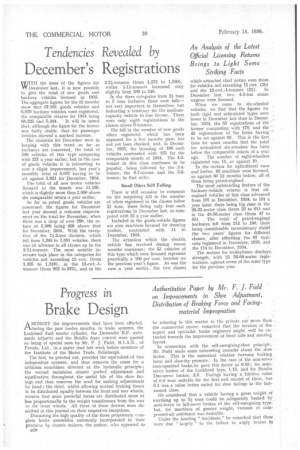Tendencies Revealed by
Page 30

If you've noticed an error in this article please click here to report it so we can fix it.
December's Registrations
An Analysis of the Latest Official Licensing Returns Brings to Light Some Striking Facts
MUTH the issue of the figures for W December last, it is now possible to give the total of new goods and hackney vehicles licensed in 1935. The aggregate figures for the 12 months show that 67.881 goods vehicles and 6,879 hackney vehicles were registered, the comparable returns for 1934 being
68,225 and 5.384. It will be noted that, although the figure for the former was fairly stable, that for passenger vehicles showed a marked increase.
The statistics for December were in keeping with this trend so far as hackneys are concerned, the total of r,86 vehicles of this type comparing with 327 a year earlier, but in the case of goods vehicles it is interesting to note a slight improvement, last year's monthly total of 6,037 having to be set against 5.631 for December, 1934.
rhe total of all new motor vehicles licensed in the month was 31,199, which is slightly more than 2,000 above the comparable return a year earlier.
So far as petrol goods vehicles are concerned, the figures for December last year showed a welcome improvement on the total for November, when there was a drop of over 260, the return at 5,809 being 429 above that for December, 1934. With the exception of the 11-2-ton division, which fell from 1,245 to 1,051 vehicles, there was an advance in all classes up to the 2-21-tonners. The most notable increases toek place in the categories for vehicles not exceeding 12 cwt. (from 1,025 to 1,319), in the 12-cwt.-Itonners (from 902 to 973), and in the 221-tonners (from 1,273 to 1,580), whilst 1-11-tonners increased only slightly from 509 to 540.
In the three categories from 21 tons to 5 tons inclusive there were falls— not very important in themselves, but indicating a tendency for the mediumcapacity vehicle to lose favour. There were only eight registrations in the classes above 6-tonners.
The fall in the number of new goods oilers registered. which has been apparent for a few months past, has not yet been checked, and, in December, 1935, the licensing of 100 such vehicles contrasted with 155 for the comparable month of 1934. The 4-5tonner in this class continues to be popular, being followed by the 3-4tonner, the 6-7-tonner and the 5-6tomer, in that order.
Small Oilers Still Falling.
There is still occasion to comment on the surprising fall in the number of oilers registered in the classes below 21 tons, there being only four such _ registrations in December last, as compared with 33 a year earlier.
Included in the goods-vehicle figures are nine machines licensed for drawing trailers, contrasted with 11 in December, 1934.
The attention which the electric vehicle has received during recent months continues; the 55 vehicles of this type which were licensed represent practically a 100 per cent, increase on the previous year's figure. As was the case a year earlier, the two classes which attracted chief notice were those for vehicles not exceeding 12 cwt. (30) and the 12-cwt.-1-tonners (21). In December last, two 4-5-ton steam wagons were licensed.
When we come to six-wheeled vehicles, we find that the figures for both rigid and articulated types were lower in December last than in •Deceniber, 1934, the 55 registrations of the former contrasting with 178, and the 45 registrations of the, latter having' to be set against 69. This is the first time for some months that the total' • for articulated six-wheelers has been below the comparable return of a year ago. The number of eight-wheelers registered was 13, as against 10.
In the section for agricultural vans and lorries, 65 machines were licensed, as against 60 12 months before, all of them being petrol-engined.
The most outstanding feature of the hackney-vehicle returns is that oilengined vehicles of this class advanced from 107 in Deceniber, 1934, to 181 a year later, there being big rises in the 26-32-seater class (from 23 to 61) and in the 48-56-seater class (from 47 to 85). The total of petrol-engined hackneys fell from 213 to 180, there being considerable inconsistency about the two years' figures for different classes, after offsetting the 97 taxicabs registered in December, 1935, and the 114 in December, 1934.
The section for trolleybuses displays, strength, with 25 56-64-seater registrations, against seven of the same type for the previous year.




















































































